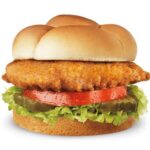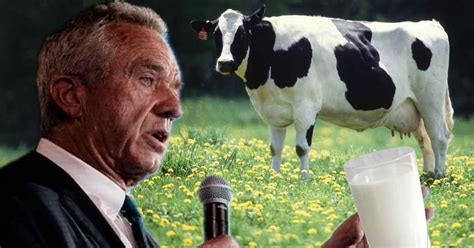
Robert F. Kennedy Jr.’s daily consumption of raw milk is raising concerns among health experts, who warn about the potential dangers of ingesting unpasteurized dairy products, particularly the risk of bacterial infections. Kennedy’s campaign confirmed his habit after he revealed during a campaign stop in Los Angeles that he drinks raw milk, despite warnings from health officials regarding the significant health risks associated with it.
Robert F. Kennedy Jr.’s consumption of raw milk has sparked considerable debate and concern, drawing attention to the potential health risks associated with consuming unpasteurized dairy products. The revelation came during a campaign stop in Los Angeles, where Kennedy openly discussed his daily habit, despite widespread warnings from health officials and organizations regarding the dangers of bacterial contamination. His campaign has confirmed that this is a regular practice for Kennedy.
Raw milk is milk that has not been pasteurized to kill harmful bacteria. The Centers for Disease Control and Prevention (CDC), the Food and Drug Administration (FDA), and other public health entities strongly advise against consuming raw milk due to the risk of serious infections. These infections can be caused by bacteria such as E. coli, Salmonella, Listeria, and Campylobacter, which can lead to severe illness, hospitalization, and, in rare cases, death.
“Raw milk can carry harmful germs that can make you very sick,” the CDC states on its website, emphasizing that pasteurization is the only way to kill these bacteria.
Kennedy’s advocacy for alternative health practices has often placed him at odds with mainstream medical consensus. His stance on vaccines, for example, has been widely criticized by medical professionals who cite overwhelming scientific evidence supporting vaccine safety and efficacy. His consumption of raw milk aligns with this pattern, raising questions about his understanding and acceptance of established health guidelines.
The potential health risks associated with raw milk consumption are well-documented. According to the FDA, raw milk can contain dangerous bacteria that pasteurization is designed to eliminate. Pasteurization involves heating milk to a specific temperature for a set period to kill these pathogens without significantly affecting its nutritional value.
“Raw milk might contain harmful bacteria that can make you very sick or kill you,” the FDA warns. Symptoms of illness from contaminated raw milk can include vomiting, diarrhea, abdominal pain, fever, and dehydration. In vulnerable populations, such as children, pregnant women, the elderly, and individuals with weakened immune systems, these infections can be particularly severe and life-threatening.
The CDC estimates that unpasteurized milk is 150 times more likely to cause foodborne illness than pasteurized milk and accounts for a disproportionate number of outbreaks. A study published in the journal Emerging Infectious Diseases found that from 1993 to 2012, raw milk was responsible for 81 outbreaks, 63 hospitalizations, and three deaths in the United States.
Health experts emphasize that the risks associated with raw milk consumption outweigh any perceived benefits. Some proponents of raw milk claim that it has superior nutritional qualities and contains beneficial enzymes and probiotics that are destroyed during pasteurization. However, scientific evidence does not support these claims. Nutritional differences between raw and pasteurized milk are minimal, and any potential benefits of raw milk do not outweigh the significant risk of infection.
“There is no demonstrated health benefit to drinking raw milk that offsets the risk of microbial infection,” says Dr. William Schaffner, an infectious disease expert at Vanderbilt University Medical Center. “Pasteurization is a very effective way to eliminate pathogens without significantly altering the nutritional content of milk.”
Kennedy’s decision to consume raw milk also raises ethical concerns. As a public figure and potential political leader, his actions and statements can influence public opinion and behavior. By openly endorsing raw milk consumption, he may inadvertently encourage others to disregard public health recommendations and expose themselves to unnecessary risks.
The debate over raw milk is not new. Proponents argue that consumers have the right to choose what they eat and drink and that raw milk is a natural and wholesome food. They also claim that small-scale, local dairy farms that produce raw milk adhere to strict hygiene standards that minimize the risk of contamination.
However, health officials maintain that even under the best conditions, raw milk can still harbor harmful bacteria. The pasteurization process is a standardized and reliable method of ensuring milk safety, regardless of the size or location of the dairy farm.
“There is no safe raw milk,” says Dr. Robert Tauxe, director of the CDC’s Division of Foodborne, Waterborne, and Environmental Diseases. “Even if the dairy farm follows strict hygiene practices, there is still a risk of contamination. Pasteurization is the only way to eliminate that risk.”
Kennedy’s consumption of raw milk is not just a personal choice; it is a public health issue. His actions have the potential to undermine public health efforts to promote safe food practices and prevent foodborne illnesses.
The International Association for Food Protection (IAFP) has also issued strong statements against the consumption of raw milk. The IAFP emphasizes that pasteurization is a critical food safety intervention that has significantly reduced the incidence of milk-borne diseases.
“The IAFP supports the pasteurization of milk as a means of protecting public health,” the organization states. “There is no justification for consuming raw milk when pasteurized milk is readily available and provides the same nutritional benefits without the risk of infection.”
Beyond the immediate health risks, Kennedy’s advocacy for raw milk also reflects a broader trend of skepticism toward scientific expertise and public health recommendations. This trend has been fueled by misinformation and conspiracy theories, which can have serious consequences for public health.
During the COVID-19 pandemic, for example, misinformation about vaccines and treatments led to widespread vaccine hesitancy and contributed to the spread of the virus. Similarly, misinformation about raw milk can lead people to make choices that put their health at risk.
Kennedy’s campaign has not yet issued a detailed statement addressing the concerns raised by his raw milk consumption. However, it is likely that he will defend his personal choices and argue that consumers have the right to choose what they eat and drink.
Regardless of his personal beliefs, it is important for Kennedy to acknowledge the potential health risks associated with raw milk and to avoid promoting practices that could endanger public health. As a public figure, he has a responsibility to promote accurate information and to support evidence-based public health recommendations.
The controversy surrounding Kennedy’s raw milk consumption highlights the ongoing tension between individual liberty and public health. While individuals have the right to make their own choices about what they eat and drink, these choices should be informed by accurate information and should not endanger the health of others.
In conclusion, Robert F. Kennedy Jr.’s daily consumption of raw milk raises significant public health concerns. Health experts and organizations overwhelmingly warn against the consumption of raw milk due to the risk of serious bacterial infections. While Kennedy may have his own reasons for consuming raw milk, it is important for him to acknowledge the potential risks and to avoid promoting practices that could undermine public health efforts. The debate over raw milk underscores the importance of evidence-based decision-making and the need for public figures to promote accurate information about health and safety. His actions have the potential to influence others, making it imperative that he considers the broader implications of his choices on public health.
Expanding on the Risks of Raw Milk:
The dangers associated with raw milk extend beyond the mere presence of bacteria. The complex nature of milk itself, as a rich medium for microbial growth, makes it particularly susceptible to contamination. Even when raw milk is produced under seemingly stringent conditions, the risk of contamination remains.
-
Pathogen Complexity: Raw milk can harbor a variety of pathogens, each with its own unique characteristics and potential to cause illness. E. coli O157:H7, for instance, is a particularly virulent strain of E. coli that can cause severe diarrhea, abdominal cramps, and even kidney failure (hemolytic uremic syndrome), especially in children. Salmonella can lead to gastroenteritis, characterized by fever, diarrhea, and abdominal pain. Listeria monocytogenes poses a significant threat to pregnant women, as it can cause miscarriage, stillbirth, or severe illness in newborns. Campylobacter is a common cause of diarrhea and can sometimes lead to Guillain-Barré syndrome, a rare but serious autoimmune disorder.
-
Environmental Contamination: The sources of contamination in raw milk are varied and can occur at any point in the production process. Bacteria can be present on the cow’s udder, in the surrounding environment, or even introduced during milking or handling. Even with careful hygiene practices, it is nearly impossible to eliminate all sources of contamination.
-
Storage and Handling: Improper storage and handling of raw milk can further increase the risk of bacterial growth. Bacteria multiply rapidly at room temperature, so it is essential to keep raw milk refrigerated at all times. However, even refrigeration cannot completely halt bacterial growth.
-
Lack of Pasteurization: Pasteurization is a critical step in ensuring the safety of milk. The process involves heating milk to a specific temperature for a set period, which effectively kills most harmful bacteria without significantly affecting the nutritional value or taste of the milk. Raw milk proponents often argue that pasteurization destroys beneficial enzymes and nutrients, but scientific evidence does not support these claims. Any potential benefits of raw milk are far outweighed by the risk of infection.
-
Vulnerable Populations: The risks associated with raw milk are particularly pronounced for vulnerable populations, including infants, children, pregnant women, the elderly, and individuals with weakened immune systems. These individuals are more likely to develop severe complications from foodborne illnesses.
Scientific Scrutiny and Counterarguments:
Despite the overwhelming scientific consensus against raw milk consumption, proponents continue to argue for its benefits and safety. Their arguments often include claims that raw milk is more nutritious, contains beneficial enzymes and probiotics, and is produced under strict hygiene standards on small-scale farms. However, these claims are not supported by scientific evidence.
-
Nutritional Value: While raw milk may contain slightly higher levels of certain vitamins and minerals compared to pasteurized milk, the differences are minimal and do not outweigh the risk of infection. Moreover, pasteurized milk is often fortified with vitamins D and A, making it nutritionally equivalent or even superior to raw milk.
-
Enzymes and Probiotics: Some proponents claim that raw milk contains beneficial enzymes and probiotics that are destroyed during pasteurization. However, the enzymes present in raw milk are primarily those produced by the cow, not those that aid in human digestion. Additionally, the levels of probiotics in raw milk are often low and inconsistent, and there is no evidence that they provide significant health benefits.
-
Hygiene Standards: While small-scale, local dairy farms may adhere to strict hygiene standards, even the best practices cannot eliminate the risk of contamination. Bacteria can be present on the cow’s udder or in the surrounding environment, and there is no way to guarantee that raw milk is completely free from pathogens.
-
Consumer Choice: Proponents of raw milk often argue that consumers have the right to choose what they eat and drink. However, this argument ignores the potential public health consequences of raw milk consumption. Foodborne illnesses can spread to others, and the cost of treating these illnesses can burden the healthcare system.
Public Health Recommendations and Regulatory Landscape:
Given the well-documented risks associated with raw milk consumption, public health organizations and regulatory agencies have issued strong recommendations against its consumption.
-
CDC and FDA: The CDC and FDA strongly advise against consuming raw milk due to the risk of serious infections. They emphasize that pasteurization is the only way to kill harmful bacteria in milk and that there is no safe raw milk.
-
State Regulations: The sale and distribution of raw milk are regulated at the state level. Some states allow the sale of raw milk in retail stores, while others only permit on-farm sales or prohibit it altogether. The regulatory landscape is complex and varies widely across the country.
-
International Standards: Many countries around the world have banned or severely restricted the sale of raw milk due to the risk of foodborne illnesses.
The Broader Context of Health Skepticism:
Kennedy’s consumption of raw milk is not an isolated incident. It reflects a broader trend of skepticism toward scientific expertise and public health recommendations. This trend has been fueled by misinformation, conspiracy theories, and a distrust of authority.
-
Vaccine Hesitancy: Kennedy has been a vocal critic of vaccines, despite overwhelming scientific evidence supporting their safety and efficacy. His views on vaccines have been widely criticized by medical professionals.
-
Alternative Medicine: Kennedy has also expressed support for alternative medicine practices, some of which lack scientific evidence of effectiveness.
-
Misinformation: The spread of misinformation about health and science can have serious consequences for public health. It can lead people to make choices that put their health at risk and undermine public health efforts to promote safe practices.
Kennedy’s actions as a public figure, therefore, carry significant weight. His endorsement of practices like raw milk consumption can inadvertently legitimize unsubstantiated claims and encourage others to disregard established health guidelines, thereby creating a public health hazard.
The conversation surrounding Kennedy’s raw milk habit serves as a reminder of the critical role that accurate information and evidence-based decision-making play in safeguarding public health. It highlights the ongoing need for public health officials and organizations to communicate effectively with the public and to counter misinformation with credible scientific evidence. Furthermore, it underscores the responsibility of public figures to promote accurate information and to avoid endorsing practices that could endanger public health.
FAQ:
-
What is raw milk?
Raw milk is milk that has not been pasteurized to kill harmful bacteria. Pasteurization is a process that involves heating milk to a specific temperature for a set period to eliminate pathogens without significantly affecting its nutritional value. “Raw milk can carry harmful germs that can make you very sick,” according to the CDC.
-
Why is raw milk considered dangerous?
Raw milk can contain harmful bacteria such as E. coli, Salmonella, Listeria, and Campylobacter, which can cause serious infections. Symptoms of illness from contaminated raw milk can include vomiting, diarrhea, abdominal pain, fever, and dehydration. In vulnerable populations, these infections can be particularly severe and life-threatening. The FDA warns, “Raw milk might contain harmful bacteria that can make you very sick or kill you.”
-
What are the potential health risks associated with consuming raw milk?
Consuming raw milk can lead to severe illness, hospitalization, and, in rare cases, death. Vulnerable populations, such as children, pregnant women, the elderly, and individuals with weakened immune systems, are at a higher risk of developing serious complications from foodborne illnesses caused by raw milk. A study in Emerging Infectious Diseases found that raw milk was responsible for 81 outbreaks, 63 hospitalizations, and three deaths in the U.S. from 1993 to 2012.
-
Is raw milk more nutritious than pasteurized milk?
While raw milk may contain slightly higher levels of certain vitamins and minerals compared to pasteurized milk, the differences are minimal and do not outweigh the risk of infection. Pasteurization does not significantly alter the nutritional content of milk, and pasteurized milk is often fortified with vitamins D and A, making it nutritionally equivalent or even superior to raw milk. Dr. William Schaffner states, “There is no demonstrated health benefit to drinking raw milk that offsets the risk of microbial infection.”
-
What do public health organizations recommend regarding raw milk consumption?
Public health organizations such as the CDC, FDA, and IAFP strongly advise against consuming raw milk due to the risk of serious infections. These organizations emphasize that pasteurization is a critical food safety intervention that has significantly reduced the incidence of milk-borne diseases. Dr. Robert Tauxe of the CDC says, “There is no safe raw milk. Even if the dairy farm follows strict hygiene practices, there is still a risk of contamination. Pasteurization is the only way to eliminate that risk.”
Expanding on the regulatory landscape of raw milk sales and consumption in the United States and Globally:
The regulation of raw milk varies considerably across the United States and around the world, reflecting differing perspectives on consumer choice, public health, and agricultural practices.
United States:
- State-Level Regulation: In the U.S., the regulation of raw milk is primarily determined at the state level. This has resulted in a patchwork of laws, ranging from outright bans to relatively permissive frameworks.
- Prohibition States: Some states completely prohibit the sale of raw milk for human consumption. These states generally view the risks associated with raw milk as outweighing any potential benefits and prioritize public health above consumer choice.
- Permissive States: Other states allow the retail sale of raw milk, subject to certain conditions. These conditions may include licensing requirements, regular inspections of dairy farms, bacterial testing, and labeling requirements to inform consumers about the risks of consuming raw milk.
- On-Farm Sales: Many states permit the sale of raw milk directly from farms to consumers. This is often seen as a compromise between allowing consumer access to raw milk and maintaining some level of regulatory oversight. On-farm sales may be subject to restrictions on advertising, volume limits, and requirements for informing consumers about the risks.
- Cow-Share Programs: Some states allow cow-share programs, where consumers can purchase shares in a cow or herd and receive raw milk as a benefit of ownership. These programs are often seen as a way to circumvent regulations on the sale of raw milk, but they may also be subject to specific rules and requirements.
- Federal Oversight: While the primary responsibility for regulating raw milk rests with the states, the federal government also plays a role. The FDA prohibits the interstate sale of raw milk for human consumption, meaning that raw milk cannot be legally transported across state lines for sale.
Global Regulations:
The regulation of raw milk varies significantly around the world, reflecting different cultural attitudes, public health priorities, and agricultural practices.
- Canada: In Canada, the sale of raw milk is generally prohibited. However, some provinces allow the consumption of raw milk on farms where it is produced.
- European Union: The European Union allows member states to regulate the sale of raw milk, subject to certain food safety standards. Some countries, such as France and Italy, have a relatively permissive approach to raw milk sales, while others, such as the United Kingdom, have stricter regulations.
- United Kingdom: In the UK, the sale of raw milk is permitted, but it is subject to strict regulations, including licensing requirements, regular inspections, and labeling requirements. Raw milk can only be sold directly to consumers at the farm gate or through registered farmers’ markets.
- Australia: In Australia, the sale of raw milk for human consumption is generally prohibited. However, some states allow the sale of raw milk for cosmetic purposes, such as bathing.
- New Zealand: New Zealand allows the sale of raw milk under strict regulations, including registration of producers, regular testing of milk, and labeling requirements. Raw milk can only be sold directly to consumers from the farm or through registered delivery services.
- Developing Countries: In many developing countries, raw milk is commonly consumed due to a lack of infrastructure for pasteurization and refrigeration. However, this can pose significant public health risks, as raw milk in these settings may be more likely to be contaminated with pathogens.
The Future of Raw Milk Regulation:
The debate over raw milk is likely to continue, as proponents and opponents continue to advocate for their respective positions. The future of raw milk regulation will depend on a number of factors, including:
- Public Health Concerns: Outbreaks of foodborne illnesses linked to raw milk will likely prompt calls for stricter regulations.
- Consumer Demand: Continued consumer demand for raw milk may lead to pressure for more permissive regulations.
- Scientific Evidence: New scientific evidence on the risks and benefits of raw milk may influence regulatory decisions.
- Political Factors: Political considerations, such as lobbying by dairy farmers and consumer advocacy groups, will also play a role in shaping the regulatory landscape.
Ultimately, the regulation of raw milk will require a careful balancing of public health concerns, consumer choice, and agricultural interests. It is essential that regulatory decisions are based on the best available scientific evidence and that consumers are fully informed about the risks and benefits of consuming raw milk.
Ethical considerations of public figures endorsing alternative health practices:
When public figures endorse alternative health practices, such as consuming raw milk, several ethical considerations come into play. These considerations are particularly important because public figures have a broad reach and influence, and their endorsements can have a significant impact on public opinion and behavior.
- Informed Consent: Public figures have a responsibility to ensure that their endorsements are based on accurate information and that they are not misleading or deceptive. They should avoid making claims about the benefits of alternative health practices that are not supported by scientific evidence. Consumers have a right to make informed decisions about their health, and public figures should not undermine this right by promoting unsubstantiated claims.
- Potential Harm: Public figures should be aware of the potential harm that can result from endorsing alternative health practices. Some alternative practices may be ineffective, while others may be harmful or dangerous. Public figures should avoid endorsing practices that have not been adequately tested for safety and efficacy.
- Vulnerable Populations: Public figures should be particularly cautious about endorsing alternative health practices that may appeal to vulnerable populations, such as children, pregnant women, and individuals with chronic illnesses. These populations may be more susceptible to misinformation and may be more likely to be harmed by ineffective or dangerous practices.
- Conflicts of Interest: Public figures should disclose any conflicts of interest that may influence their endorsements of alternative health practices. For example, if a public figure has a financial stake in a company that sells raw milk, they should disclose this information when endorsing raw milk consumption.
- Responsibility to the Public: Public figures have a responsibility to the public to promote accurate information about health and science. They should avoid promoting practices that could endanger public health or undermine evidence-based medicine.
- Trust and Credibility: Public figures often enjoy a high degree of trust and credibility, which can make their endorsements particularly influential. They should be aware of this influence and should use it responsibly. They should avoid promoting practices that could erode public trust in science and medicine.
- Context and Nuance: Public figures should be careful to provide context and nuance when discussing alternative health practices. They should acknowledge the limitations of the evidence and should avoid making sweeping generalizations.
- Avoiding Misinformation: Public figures should actively combat misinformation about health and science. They should use their platforms to promote accurate information and to debunk myths and falsehoods.
In the case of Robert F. Kennedy Jr.’s endorsement of raw milk consumption, these ethical considerations are particularly relevant. Kennedy’s views on vaccines have already drawn criticism from medical professionals, and his endorsement of raw milk further undermines public health efforts to promote safe food practices. As a public figure and potential political leader, Kennedy has a responsibility to promote accurate information and to avoid endorsing practices that could endanger public health.
The ethical responsibility falls on public figures to balance their personal choices with the potential impact their actions have on the wider community. This requires a commitment to evidence-based decision-making and a willingness to prioritize public health over personal preferences.









